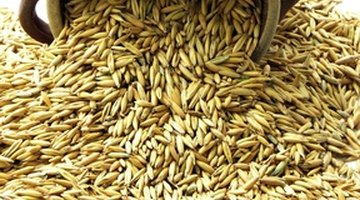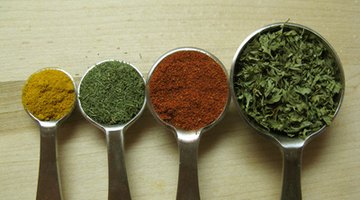Some dogs need help to digest in a happy and healthy way. If your dog suffers from digestive irregularity, diarrhoea or constipation, you can add oat bran to your pet's meal once a day and support its level of dietary fibre. Oat bran is one of the highest sources of natural fibre in the diet and is also a rich source of minerals such as manganese, iron, phosphorous, selenium and calcium. Decide whether oat bran is right for your pet and use it to support a balanced and healthy diet plan.
- Some dogs need help to digest in a happy and healthy way.
- If your dog suffers from digestive irregularity, diarrhoea or constipation, you can add oat bran to your pet's meal once a day and support its level of dietary fibre.

Decide whether supplementing with oat bran is appropriate for your pet. Dogs do not require the same diet consisting of carbohydrates and fibre that is important in human nutrition. According to Lew Olson, author of "Raw & Natural Nutrition for Dogs," dogs do not have the amylase enzymes or digestive tract needed for digesting and absorbing grains. Only in some cases should dogs be supplemented with fibre, Olson said, such as for puppies coming off milk, to support lactating mothers, and to help remedy constipation and diarrhoea.

Check the nutritional analysis of your dog food if you are purchasing commercial products for your pet. Most balanced formulated animal foods will have bits of rice, vegetable or bran added to increase the fibre content. If the pet food you are currently using contains as much as 5 per cent fibre, you probably do not need to supplement with oat bran. Oat bran is extremely high in fibre and is to be used alongside home-prepared meals and raw meat.

Purchase a high-quality source of oat bran. All oat products are sensitive to heat and sunlight and will denature if left exposed to open air and UV light. Choose oat bran sold in airtight containers. If selecting oat bran from bulk, purchase only if the oat bran is covered with a lid. Often the smell of oat bran will tell you if it is fresh or not; it should have a sweet, grassy scent. If it begins to smell bitter or pungent, it has likely gone bad.
- Check the nutritional analysis of your dog food if you are purchasing commercial products for your pet.
- All oat products are sensitive to heat and sunlight and will denature if left exposed to open air and UV light.

Add small amounts of oat bran to your dog's food. Dogs do not have teeth for grinding grains, so mix the oat bran with their food. This may be easiest with canned foods or wet meats. Start with the smallest dosage to test how your dog will cope with the extra fibre. Viv Harris, author of "The Healthy Animal Handbook," recommends 1/2 teaspoon added to food once daily. This can be increased to 1 teaspoon or even 2 teaspoons in large dogs if it is tolerated, but the dosage needs to be increased very gradually. Monitor your pet during this time and be prepared to reduce the dosage if it suffers digestive troubles.
- Add small amounts of oat bran to your dog's food.
- Viv Harris, author of "The Healthy Animal Handbook," recommends 1/2 teaspoon added to food once daily.
TIP
Make sure your dog has fresh water at all times. Oat bran may absorb water from the digestive tract, making your dog thirstier than normal.
WARNING
Consult with your dog's veterinarian before altering your dog's diet. Too much fibre in the diet may cause digestive discomfort, irritable bowel syndrome and digestive bleeding in your dog. Be careful and watch your dog carefully to make sure it is digesting the oat bran properly. If your dog suffers from flatulence, smelly stools, bloating or lethargy following oat bran supplementation, discontinue usage.
